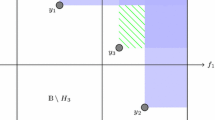Abstract
Design is a multi-objective decision-making process considering manufacturing, cost, aesthetics, usability among many other product attributes. The set of optimal solutions, the Pareto set, indicates the trade-offs between objectives. Decision-makers generally select their own optima from the Pareto set based on personal preferences or other judgements. However, uncertainties from manufacturing processes and from operating conditions will change the performances of the Pareto optima. Evaluating the impacts of uncertainties on Pareto optima requires a large amount of data and resources. Comparing multiple Pareto solutions under uncertainty are also very costly. In this work, local Pareto set approximation is integrated with uncertainty propagation technique to quantify design variations in the objective space. An optimality influence range is proposed using linear combinations of objective functions that creates a more accurate polygon objective variation subspace. A set of ‘virtual samples’ is then generated to form two quantifications of the objective variation subspace, namely an influence noise to indicate how a design remains optimal, and an influence range that quantifies the overall variations of a design. In most engineering practices, a Pareto optimum with a smaller influence noise and a smaller influence range is preferred. We also extend the influence noise/range concept to nonlinear Pareto set with the second-order approximation. The quadratic local Pareto approximation method in the literature is also extended in this work to solve multi-objective engineering problems with black-box functions. The usefulness of the proposed quantification method is demonstrated using a numerical example as well as using an engineering problem in structural design.
Similar content being viewed by others
References
Allison J., Kokkolaras M., Papalambros P. (2007) On selecting single-level formulations for complex system design optimization. Journal of Mechanical Design 129: 898
Doltsinis I., Kang Z. (2004) Robust design of structures using optimization methods. Computer Methods in Applied Mechanics and Engineering 193(23-26): 2221–2237
Du X., Chen W. (2002) Efficient uncertainty analysis methods for multidisciplinary robust design. AIAA Journal 40(3): 545–552
Enevoldsen I., Sørensen J. (1994) Reliability-based optimization in structural engineering. Structural Safety 15(3): 169–196
Giassi A., Bennis F., Maisonneuve J.-J. (2004) Multidisciplinary design optimisation and robust design approaches applied to concurrent design. Structural and Multidisciplinary Optimization 28(5): 356–371
Hung, T.-C., & Chan, K.-Y. (2011). Multi-objective design and tolerance allocation for single- and multi-level systems. Journal of Intelligence Manufacturing. doi:10.1007/s10845-011-0608-3.
Jung D., Lee B. (2002) Development of a simple and efficient method for robust optimization. International Journal for Numerical Methods in Engineering 53(9): 2201–2215
Lee K.-H., Park G.-J. (2001) Robust optimization considering tolerances of design variables. Computers & Structures 79(1): 77–86
Li M., Azarm S. (2008) Multiobjective collaborative robust optimization with interval uncertainty and interdisciplinary uncertainty propagation. Journal of Mechanical Design 130: 081402
Mattson C., Messac A. (2005) Pareto frontier based concept selection under uncertainty, with visualization. Optimization and Engineering 6: 85–115
Neufville R. (1990) Applied system analysis. McGraw-Hill, New York, NY
Rachev S., Stoyanov S., Fabozzi F. (2008) Advanced stochastic models, risk assessment, and portfolio optimization: The ideal risk, uncertainty, and performance measures. Wiley, New York
Tappeta R., Renaud J. (1997a) Multiobjective collaborative optimization. Journal of Mechanical Design 119: 403–411
Tappeta R., Renaud J. (1997b) A comparison of equality constraint formulations for concurrent design optimization. Concurrent Engineering 5(3): 253–261
Utyuzhnikov S., Maginot J., Guenov M. (2008) Local Pareto approximation for multi-objective optimization. Engineering Optimization 40(9): 821–847
Author information
Authors and Affiliations
Corresponding author
Rights and permissions
About this article
Cite this article
Hung, TC., Chan, KY. Uncertainty quantifications of Pareto optima in multiobjective problems. J Intell Manuf 24, 385–395 (2013). https://doi.org/10.1007/s10845-011-0602-9
Received:
Accepted:
Published:
Issue Date:
DOI: https://doi.org/10.1007/s10845-011-0602-9




